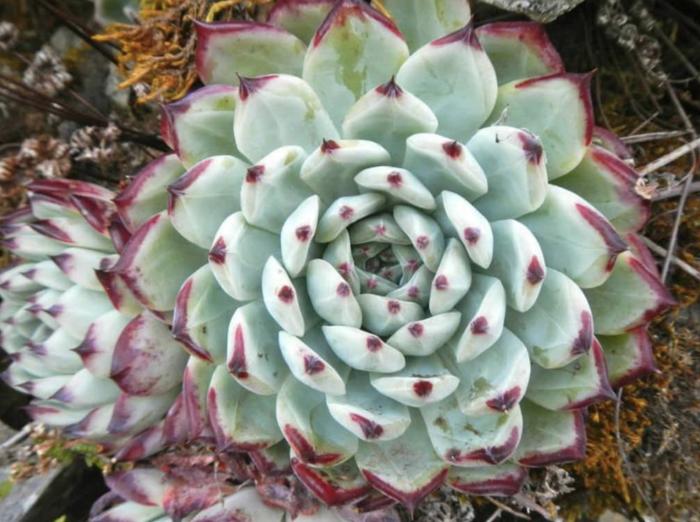Echeveria colorata
Hens and chicks

Description
Echeverias, commonly called “hens and chicks”, are widely appreciated by California gardeners, both as potted plants and as bedding plants. Many of them have neat flower-like rosettes of leaves, and this is certainly true of Echeveria colorata, from the vicinity of Guadalajara in the Mexican state of Jalisco. The thick leaves of E. colorata are white to bluish-white with rosy tips, and in time they will put out a modest number of offsets, though they are not nearly as prolific as some other species such as Echeveria elegans. Typically, the rosettes are about 4 to 5 inches across, but larger forms can approach a foot in diameter. The slender flower stalks of Echeveria colorata emerge around the beginning of March, rising to a height of a foot to a foot and a half and arching over at the tips. The stalk itself is pink, and the outside of the urn-shaped flowers is pink to pinkish-red, with the flared petal tips often grading to yellow-orange. The inside of the flowers is yellow to yellow-orange. At the bud stage, the flowers point downward, but they rotate outward as they open, and then turn upward as they go by, so that the seed capsules develop in an upright position. Echeveria colorata is invariably found growing on rocks in nature, and it makes a great rock-garden specimen. If planted on level ground, a fast-draining mix should be used. This plant looks its best with some direct sun, so that the red in the leaf tips is accentuated and the rosettes remain tight. In hotter inland areas, full sun should be avoided so that the plants do not get scorched during summer hot spells, but under coastal conditions it can take all-day sun. E. colorata can endure temperatures down to the mid-twenties Fahrenheit, but should be protected from anything colder than this.
Sun
Full, Half
Water
Low
Growth Rate
Moderate
Soil Type
Sandy, Loam, Rocky
Soil Condition
Well-drained, Dry
Soil pH
Neutral
Adverse Factors
n/a
Water Saving Tip:
Apply as little fertilizer as possible.
If you use fertilizer make sure it stays on the landscape, and carefully water it in so there is NO runoff.